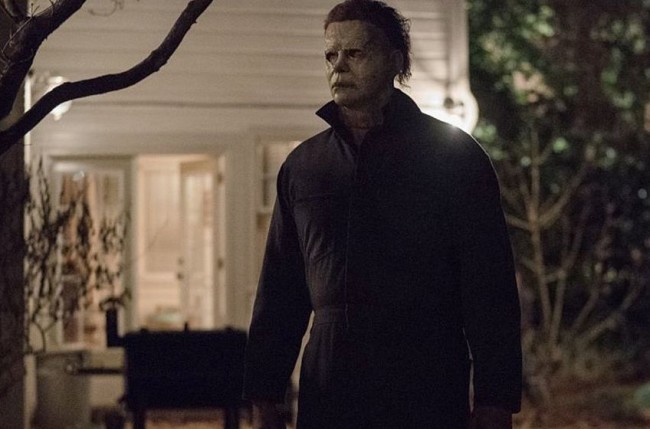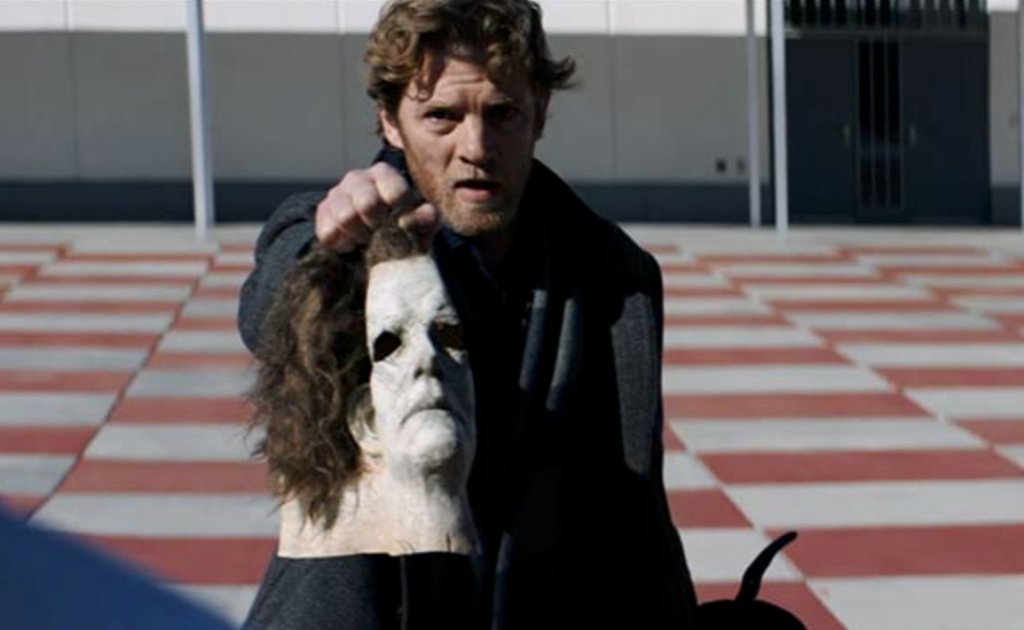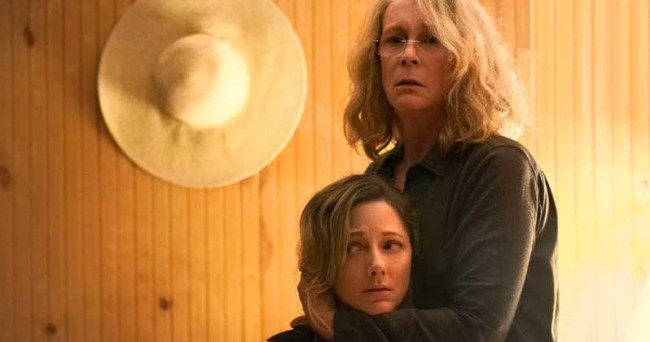Genre: Horror
Premise: (from IMDB) Laurie Strode comes to her final confrontation with Michael Myers, the masked figure who has haunted her since she narrowly escaped his killing spree on Halloween night four decades ago.
About: The chameleon’esque David Gordon Green (Pineapple Express) won this sequel by pitching his unique take on the franchise: “What if none of the sequels happened?” Funny enough, he didn’t yet know if he could get Jamie Lee Curtis for the part. Before landing her, he considered doing a Force Awakens soft-reboot approach. But Curtis signed on within 24 hours of reading the script, and a buzzy Halloween project was on its way.
Writers: David Gordon Green, Danny McBride, Jeff Fradley (characters by John Carpenter and Debra Hill)
Details: 105 minutes
The opening scene of Halloween (2018) does something so drastically wrong, I was convinced the movie was doomed. I’ll get to that mistake in a second. But first, it’s time to give credit to this reboot. There is nothing cooler in Hollywood than a surprise hit – when a film does better than everyone expected (77 million dollar opening weekend!). It reminds us not only what’s possible, but of why we became drawn to this industry in the first place. To chase the high of one day writing a movie that everybody goes to see.
For those who haven’t seen the film, the original “Final Girl,” Laurie Strode, is all grown up. The 50+ grandma lives in a house/bunker of sorts, where she’s spent 40 years preparing in case the man who attacked her and killed 5 people, Michael Myers, escapes the nearby psychiatric ward. Her mother, Karen, has given up on her, while her granddaughter, Allyson, hopes to bring her back into the family fold.
Meanwhile, a couple of British podcasters are doing a podcast on the Michael Myers killing, which introduces the plot point that Michael Myers is being transferred to a prison for the end of his days. Since it wouldn’t be a movie unless that prison bus crashed, the prison bus crashes, and Laurie goes into psycho prep mode, getting her family to her house so they can wait out Michael’s arrival. After killing a half-dozen poor souls, Michael indeed shows up, and the big battle is on.
So let’s talk about that opening scene, shall we?
In it, our podcasters, Aaron and Dana, arrive at the psychiatric ward to meet the subject of their podcast, Michael Myers. They’re joined by Michael’s doctor, Dr. Sartain, and head out to a concrete yard where all the patients are tethered to sectioned-off squares. The giant lumbering Michael is in the middle of the yard, his back to us.
An eager Aaron gets right up to the edge of Michael’s allotted square and starts blabbering away. When Michael doesn’t turn around, Aaron says he “brought something” for him. He then takes out Michael’s infamous mask. As he does, the other patients begin to unravel. They start mumbling, then pacing, then grumbling, then yelping, then yelling, eventually becoming a yard full of riled up chimpanzees. Michael, however, never turns around. As this is happening, Dana looks back at Michael’s doctor, who gives her, I kid you not, an “It’s okay,” nod, allowing Aaron to continue. The scene eventually cuts to the opening titles.
On the surface, this scene is great. I loved that they did the opposite of what was expected, which is to present Michael in a small secured room, a la Hannibal Lecter. To take us outside in broad daylight, especially with all the patients constrained to their own little sections, was perfect. It started off great.
And then it fell apart.
Why are the patients jumping around, hooting and screaming like chimpanzees? They have no idea what this mask is. They don’t know what this presentation represents. But the worst part is when Dana looks back to Dr. Sartain as if to say, “Is this okay?” and Dr. Sartain nods a, “Yeah, this is fine. Let’s see what happens.”
Holdupholdupholdup.
Let me get this straight. You have a psychopathic killer. He’s being presented with the symbol of his killings. You have a bunch of people screaming at the top of their lungs. And you just… allow it to happen???
A certified doctor whose only job is to ensure the well-being of his patients is allowing something to be shown that may reignite his most dangerous patient? What kind of nonsense logic is this?
The ONLY reason any of these things are happening is because the writer wants them to, not because they would. You can never violate that contract with your audience. Once you do, consciously or subconsciously, the audience knows something is wrong. Their suspension of disbelief has either broken or cracked. I mean seriously. What doctor in their right mind is going to allow this to happen? None. Not a single one.
And that’s too bad. Because the framework for this scene is strong. But you need to hold yourself to higher standards. By being truthful, you could’ve made this scene great.
Sure enough, this foreshadowed similar problematic scenes. Laurie Strode has been presented as this backwoods badass who’s been training for battle for 40 years. Yet the first moment she encounters Michael, who she learns is somewhere outside her house, she inches her way up to the windowed door and stands there like a clueless idiot. Sure enough, Michael’s arm shoots through the window, grabs her, and starts bashing her against the door.
Why is this bad screenwriting? Because, clearly, the writer and director wanted an arm-grab-through-the-window moment. They wanted it so bad that they betrayed everything they set up in the character. They introduced her as the world’s most prepared woman, only to turn her into a bumbling moron at the FIRST CHANCE she has to take down Michael. And for what? A cool 30-second struggle? You betray your character for that?? Come on.
You might think with these scathing critiques that I disliked Halloween. You’d be wrong! I actually thought it was pretty good. Namely because of what they did with Laurie Strode. This was a surprisingly deep character. Instead of slapping a “crazy” label on Laurie then blasting us with a bunch of silly Halloween kills, this movie asks what would’ve happened to someone like this, the lone survivor of a tabloid-grabbing murder spree. And they dig deep into Laurie’s psychology, specifically her relationship with her daughter and granddaughter. I loved that they didn’t shy away from that. And it’s why moments like the door scene bothered me so much. Because they put chinks in what was a great character, especially for a 50+ year old woman. Roles with this kind of depth are rare to find for this demo.
And there were quite a few scary moments. One of my favorites was when a father and son drove up on the prison bus crash in the dead of a foggy night. With their headlights illuminating the wandering bodies of the patients on the road, you just knew Michael was out there lurking. More importantly, it went against the traditional horror setup, which is to place your characters in small spaces where there isn’t any room to maneuver. Here, it was wide open (just like the opening scene) and still terrifying as hell.
The next good scare (spoiler!!) occurred on the opposite end of the spectrum. A newly deranged Dr. Sartain places a blacked-out Michael Myers in the back seat of the cop car with Allyson. We go from the most wide-open space to the most contained. And props to the writers for drawing this moment out. Again, scenes like this are never about the struggle once the character wakes up. They’re about milking the moments UNTIL the character wakes up. You sit on that. You make the audience dread it. And dread it we do. Is there anything more terrifying than the possibility of Michael Myers waking up next you in a room you can’t escape from?
Unfortunately, Halloween feels like a script that needed 2 to 3 more drafts. The story is designed to have Laurie and Michael duke it out at her house in the final act. And had you told me that was the selling point, I’d have been excited. But everything about the climax is clumsy. For someone who’s been preparing 40 years for this, Laurie doesn’t seem to have much of a plan outside of “turn the backyard lights on.”
An easy way to tell they were rushing was the featured kitchen contraption – an island that slid out of the way revealing a secret trap door to the basement. They must’ve showed that thing opening and closing a dozen times in the last 20 minutes. It was way overused. Rewrites allow you to consolidate and streamline hiccups like that.
All in all, Halloween was a “liked it, didn’t love it” film. It had its moments. Its heart was in the right place. But you left feeling like they dropped the pumpkin. Too bad. Maybe the next one will be better.
[ ] What the hell did I just read?
[ ] wasn’t for me
[x] worth the price of admission
[ ] impressive
[ ] genius
What I learned: Create actions that oppose the setting. This always works. The idea is you have a setting, then you make a character perform an action that normally wouldn’t happen in that setting. For example, Allyson’s family is having dinner at a restaurant. Restaurants are supposed to be fun happy places where you eat and enjoy conversation. However, Laurie shows up unexpectedly, sits down, starts talking, then, out of nowhere, bursts into tears. The family becomes incredibly uncomfortable, and, boom, now we have a scene. It’s a subtle trick, this “contrast in place and action.” But it tends to work well. To understand the power of this device, imagine the exact same scene occurring, but back at the family home. It’s not nearly as interesting, is it?




